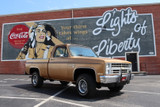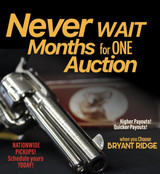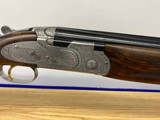*SOLD* 1943 Long Branch No.4 MKI* .303 Brit Park *CANADIAN PRODUCED WWII RIFLE*
Bryant Ridge's Analysis:
By the late 1930s, the need for a more modern and efficient rifle became apparent, and in 1941, the Rifle, No. 4 Mk I was officially adopted by the British Army. The No. 4 was an improvement over its predecessor, the No. 1 Mk III, retaining the same basic action but with enhancements that made it stronger and easier to mass-produce. The new design eliminated the nose cap found on the SMLE (Short Magazine Lee-Enfield), allowing the barrel to protrude from the end of the forend. Additionally, the charger bridge, which was rounded on the earlier models, was made more squared off for easier machining. The iron sights were redesigned for greater accuracy, with a rear receiver aperture battle sight calibrated for 300 yards (274 m). An additional ladder sight could be flipped up, offering incremental adjustments from 200 to 1,300 yards (183 to 1,189 m) in 100-yard (91 m) increments.
This new aperture sight system was quicker and more accurate than the open rear sights on Mauser rifles, earlier Enfield models, or the Buffington battle sight found on the M1903 Springfield. The No. 4 rifle was heavier than the No. 1 Mk III, primarily due to its thicker, more robust barrel. A new bayonet was developed to complement the rifle: the spike bayonet, or No. 4 bayonet, a steel rod with a sharp point that became colloquially known as the "pigsticker" among soldiers. Towards the end of World War II, a new bladed bayonet was created for the No. 5 Mk I "jungle carbine." Post-war versions of this bayonet, designated No. 7 and No. 9, were produced to fit the No. 4 rifles. To further streamline production during the war, the No. 4 was simplified with the introduction of the No. 4 Mk I* in 1942. This model replaced the bolt release catch with a simpler notch in the bolt track of the receiver, reducing complexity and easing mass production.
Production of the No. 4 Mk I* was primarily carried out by Small Arms Limited at Long Branch in Canada and by Stevens-Savage Firearms in the United States. The No. 4 rifle was mainly produced for the United Kingdom, Canada, and other Commonwealth nations, including New Zealand. In 1943, the cost of manufacturing a No. 4 Mk I rifle was £7 15s (£7.75), while a Sten Mk II submachine gun cost only £2 10s (£2.50), highlighting the cost-effective nature of the Sten as a more readily produced alternative for certain military needs.
Specifications:
- Manufacturer: Small Arms Limited by Long Branch Arsenal in Canada
- Model: No.4 MKI*
- Serial: 56L7723
- Date of Manufacture: 1943
- Caliber: .303 British
- Finish: Parkerized
- Barrel Length: 25 1/4"
- Optics/Sights: Winged Protected Blade Front with Flip-Up Adjustable Aperture Rear
- Stock/Grips: Smooth Walnut
- Action: Bolt-Action
- Markings: Standard / The left side of the receiver is stamped “NO.4 MKI* / Long Branch / 1943”. The plate above the trigger is stamped “56L7723”. The Barrel is stamped with the caliber and the importer.
Mar 31st 2025
Recent Posts
-
Museum-grade 1985 Chevrolet K10 4x4 SWB Outdoorsman
Hey, Squarebody Fans! Prepare for a jaw-dropping throwback at the Winchester Collectors Arms Show …Sep 4th 2025 -
Why You Should Consign Your Firearms with Bryant Ridge Co.
Why You Should Consign Your Firearms with Bryant Ridge Co.The Smart Choice for Your Guns! If you’r …Sep 4th 2025 -
Bryant Ridge's Featured Firearm of the Week: The King Ranch Cowboy's Dream!
Bryant Ridge's Featured Firearm of the Week: The King Ranch Cowboy's Dream! Get ready for a t …Sep 4th 2025



